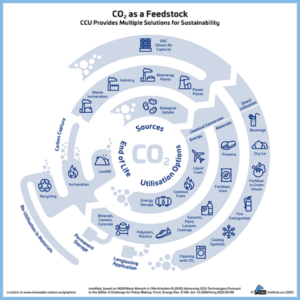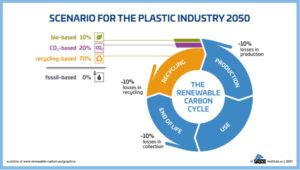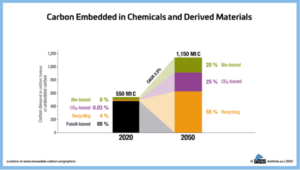In a recent report, nova-Institute made a powerful plea for ‘much more political recognition and support for CCU’. For, as they argue, carbon capture and utilization (CCU) will enable the substitution of fossil carbon in sectors where carbon is necessary. Like in aviation and in heavy industry. CCU will support the full ‘defossilisation’ of chemical and derived material industries. Moreover, it will create a circular economy, it will reduce the emission gap, promote sustainable carbon cycles, foster innovation, generate local value and stimulate job growth. In short, ‘no sustainable future without CCU’.
The world will continue to need much carbon
The background report, entitled ‘Making a Case for Carbon Capture and Utilisation (CCU) – it is much more than just a carbon removal technology’ is a science-based appeal for CO2 utilisation. It has been written on behalf of the Renewable Carbon Initiative (RCI), an alliance of more than 60 well-known companies, SMEs and start-ups. RCI looks upon CCU as one of the three available options to provide renewable carbon (the other two being biomass and recycling). But, as they write, its potential is not yet fully recognized by policy makers. Many have the misconception that CCU will just delay emissions and therefore not contribute to net-zero targets. The technology is often viewed as just a long-term storage of CO2. Whereas, according to the authors, it is essential to climate policy.
The report argues that CCU will support most Sustainable Development Goals if implemented properly. The key point is that even after a net-zero emission result, the world will need much carbon; in the chemical sector, and in products like polymers, plastics, solvents, paints, detergents, cosmetics and pharmaceuticals. ‘Several CO2-based plastics, detergents, textiles, or fuels are already in production and on the market.’ And in the future, we will need to capture more CO2.
An essential addition
‘Without CCU,’ RCI writes in its press release, ‘only recycling and biomass remain to supply the entire non-fossil carbon demand of a sustainable, defossilised future.’ But if we also have CCU, we will be able to choose among the technological options. If we do not embrace CCU, we will have to depend longer on fossil feedstock. But with CCU, we must make sure that we use renewable energy – for the technology requires quite a bit of energy.
Carbon capture and utilization, so the report writes, will supply carbon in sectors where this is an elemental feedstock – while maintaining the goods and services of these sectors. It will provide renewable carbon to industrial sectors that depend on this element, while significantly reducing carbon dioxide emissions. It will allow carbon compounds to be sourced almost anywhere on the planet – because industries that emit carbon can be found anywhere on the globe. It will store carbon in durable products; or even in short-lived products once proper carbon recycling is in place. CCU can be implemented immediately without the need for major infrastructure investments. All we need is a local infrastructure for CO2, and access to renewable hydrogen. Therefore, it will be faster, cheaper and more environmentally friendly than offsetting emissions by capturing and storing carbon dioxide (CCS).
Why isn’t there policy support for CCU, yet?
And then, the report asks why so far, there is only limited support for carbon capture and utilization, so far? And it answers that ‘the technology competes with well-established, upscaled industries that have powerful lobbies’ (like fossil industries and the biofuels sector). Moreover, because of the pressing need to reduce CO2 emissions, people tend to disregard the goal of retaining enough carbon as a feedstock for material products. Our world is so used to viewing energy policy as the main focus of preventing CO2 emissions, that the materials sector is largely disregarded. Therefore, there is not yet a global consistent CCU policy. Yes, the use of the technology for fuels production and long-term storage are acknowledged; but the production of carbon-based chemicals and materials is disregarded. Therefore, at the moment CCU policy is a ‘patchwork’. RCI favours the creation of a regulatory framework that supports CCU- and renewable carbon-based chemicals and materials.
As can be expected, the report sees carbon capture and storage (CCS) as only a choice of last resort. ‘A necessary wildcard to offset unavoidable emissions.’ But we should avoid as much as possible any ‘heavy investment in fossil CCS infrastructure’. Although CCS and CCU look more or less related through their acronyms, there is a fundamental difference. CCS just removes unwanted emissions; CCU not just reduces emissions – it also provides us with feedstock. The principal benefit is that it gives us an alternative to produce carbon containing materials! In short, the technology is essential for a successful transition towards sustainability and circularity – and should therefore receive full policy support.
Three pillars
Carbon capture and utilization is one of the three pillars required for the supply of renewable carbon in the post-fossil fuel era – the other two being recycling and biomass. Recycling can retain carbon in the cycle, but not all of it. The report estimates that this will be limited to 50–60%; there are unavoidable losses. The remaining gap can be closed by carbon from biomass and CCU (both 20-25%). There are limits to the supply of biomass because of land availability, biodiversity issues and competing options. But CCU has its issues as well. For it to be available in the required quantity, renewable energy needs to be fully developed. It is a fair assumption that this will be the case by 2050. In short, CCU is indispensable for an economy that doesn’t emit any CO2 anymore.
Captured carbon dioxide may also be useful for the production of any fuels required. The report looks upon methanol as a promising substance. Both as a feedstock for chemical industry and as an energy carrier. Much easier to handle, store and transport than hydrogen. It can make use of the already existing infrastructure of fuels.
Towards carbon management
As the report argues, we need a form of carbon management in order to let the transition proceed properly. The first task of this management will be to anticipate the current and future demand for carbon. ‘Sharing, re-using and recycling will play main roles in keeping carbon in a closed loop, in line with the Circular Economy.’ Processes need to be innovated in order to meet this goal. The entry of additional renewable carbon sources should be managed, since keeping all of the carbon in cycle isn’t technologically possible. The same sustainability requirements should apply to all renewable carbon streams – biomass, CO2 and recycling.
In sum, this will give rise to an entirely new (chemical) industry, outlined in the report. Carbon Capture and Utilization might fundamentally change the way in which we deal with carbon containing raw materials. In every region of the world, CO2 is amply available. Via CCU, each country could become its own provider of such materials. Access to solar energy might become more important than access to raw materials. Remember that solar energy is very efficient from a land use point of view, compared to biomass.
A stable carbon pool
The long-term carbon storage effect of captured carbon and derived CCU-based products will become even more significant in the future. The ‘technosphere’ (all objects created by mankind) might become a stable carbon pool, similar to a forest. We could reach recycling rates of 70 to 90% for wood, paper, concrete and plastics. If the remaining gaps in carbon demand are met by alternative renewable carbon options (bio-based and CCU), any additional carbon will be essentially circular and will not increase the size of the total carbon pool above ground. The combined amount of carbon stored in the technosphere would remain comparatively constant and could act as a reliable carbon storage option. In fact, this could serve the same goal as CCS, but with the carbon stored in our everyday products.
Some argue that industry will need energy and hence will keep on emitting CO2. But there is no scientific reason why fossil demand of the chemical industry could not be completely replaced by renewable energies and renewable feedstock alternatives.
Why isn’t there a consistent CCU policy yet?
So, with this in mind, why isn’t there a consistent and comprehensive carbon capture and utilization policy in action yet? If we restrict ourselves to Europe, the report concludes that ‘the chemical and derived materials industry has been largely overlooked in discussions around CCU.’ The sector is mentioned, but there are no political incentives for CCU; primarily due to the misconception that these applications are not net-zero technologies. CCU is often misunderstood as just a bridging technology until industries no longer require carbon. But this is a flawed assumption. Demand for carbon will always exist in certain sectors like the chemical industry. CCU will enable a future circular economy and sustainable carbon cycles.
Summing up, the document calls for the recognition of carbon capture and utilization as an important policy instrument. With its vision, strategy and targets. With the creation of demand for CCU, and the ensuing competition. With recognition of this technology as an instrument of climate policy in a sustainable economy.
Author
Diederik van der Hoeven
Source
Supplier
nova-Institut GmbH
Renewable Carbon Initiative (RCI)
Share
Renewable Carbon News – Daily Newsletter
Subscribe to our daily email newsletter – the world's leading newsletter on renewable materials and chemicals














